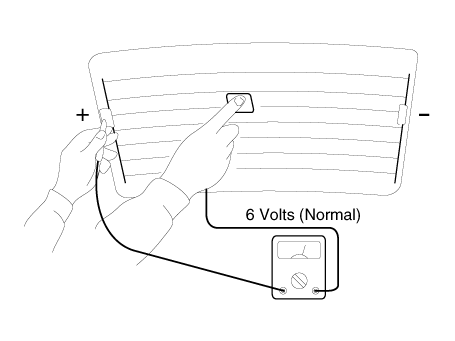Hyundai Venue: Rear Glass Defogger / Rear Glass Defogger Printed Heater. Repair procedures
Hyundai Venue (QX) (2020-2025) Service Manual / Body Electrical System / Rear Glass Defogger / Rear Glass Defogger Printed Heater. Repair procedures
| Inspection |
Wrap tin foil around the end of the voltmeter test lead to prevent damaging
the heater line. Apply finger pressure on the tin foil, moving the tin
foil along the grid line to check for open circuits.
|

| 1. |
Turn on the defogger switch and use a voltmeter to measure the voltage
of each heater line at the glass center point. If a voltage of approximately
6V is indicated by the voltmeter, the heater line of the rear window
is considered satisfactory.
|
| 2. |
If a heater line is burned out between the center point and (+) terminal,
the voltmeter will indicate 12V.
|
| 3. |
If a heater line is burned out between the center point and (-) terminal,
the voltmeter will indicate 0V.
|
| 4. |
To check for open circuits, slowly move the test lead in the direction
that the open circuit seems to exist. Try to find a point where a voltage
is generated or changes to 0V. The point where the voltage has changed
is the open-circuit point.
|
| 5. |
Use an ohmmeter to measure the resistance of each heater line between
a terminal and the center of a grid line, and between the same terminal
and the center of one adjacent heater line. The section with a broken
heater line will have a resistance twice that in other sections. In
the affected section, move the test lead to a position where the resistance
sharply changes.
|
Repair Of Broken Heater Line
Prepare the following items :
| 1. |
Conductive paint.
|
| 2. |
Paint thinner.
|
| 3. |
Masking tape.
|
| 4. |
Silicone remover.
|
| 5. |
Using a thin brush :
Wipe the glass adjacent to the broken heater line, clean with silicone
remover and attach the masking tape as shown. Shake the conductive paint
container well, and apply three coats with a brush at intervals of about
15 minutes apart. Remove the tape and allow sufficient time for drying
before applying power. For a better finish, scrape away excess deposits
with a knife after the paint has completely dried. (Allow 24 hours).
|
 Components and components location
Components and components location
Component Location
1. ICU Junction Block
2. Rear glass defogger switch (Manual type)
3. Rear glass defogger
switch (Auto type)
4...
 Rear Glass Defogger Switch. Repair procedures
Rear Glass Defogger Switch. Repair procedures
Inspection
1.
In the body electrical system, failure can be quickly diagnosed by using
the vehicle diagnostic system (Diagnostic tool)...
Other information:
Hyundai Venue (QX) (2020-2025) Service Manual: Hood Latch Release Handle. Repair procedures
Replacement 1. Pull out the hood latch release handle. 2. Separate the hood latch release handle cable (A). 3. Loosen the mounting screws and remove the hood latch release handle (A)...
Hyundai Venue (QX) (2020-2025) Service Manual: Schematic diagrams
..
Categories
- Manuals Home
- 1st Generation Venue Owners Manual
- 1st Generation Venue Service Manual
- Electronic Stability Control (ESC)
- Lighting control
- To set Cruise Control speed
- New on site
- Most important about car
Smart Key

Your HYUNDAI uses a Smart Key, which you can use to lock or unlock the driver and passenger doors or the rear liftgate.
1. Door Lock
2. Door Unlock
3. Remote start
Copyright © 2025 www.hvenueqx.com







